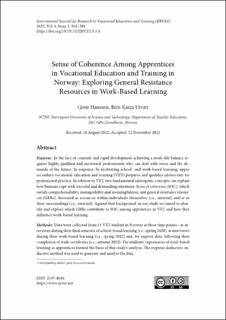| dc.description.abstract | Purpose: In the face of constant and rapid development achieving a work–life balance requires highly qualified and motivated professionals who can deal with stress and the demands of the future. In response, by facilitating school- and work-based learning, upper secondary vocational education and training (VET) prepares and qualifies adolescents for professional practice. In relation to VET, two fundamental salutogenic concepts can explain how humans cope with stressful and demanding situations: Sense of coherence (SOC), which entails comprehensibility, manageability and meaningfulness, and general resistance resources (GRRs), theorised as resources within individuals themselves (i.e., internal) and/or in their surroundings (i.e., external). Against that background, in our study we aimed to identify and explore which GRRs contribute to SOC among apprentices in VET and how they influence work-based learning.
Methods: Data were collected from 11 VET student in Norway at three time points—at interviews during their final semester of school-based learning (i.e., spring 2020), at interviews during their work-based learning (i.e., spring 2022) and, for register data, following their completion of trade certificates (i.e., autumn 2022). The students' experiences of work-based learning as apprentices formed the basis of this study's analysis. The stepwise deductive–inductive method was used to generate and analyse the data.
Findings: The apprentices' GRRs emerged in emotional, cognitive, physical, professional, social, relational, material and cultural dimensions. Identification and utilisation of GRRs were both individually and socially conditioned. The apprentices were able to identify, both consciously and unconsciously, internal GRRs to further identify external GRRs, and vice versa. Each identified GRR appeared to affect at least one, if not all, of the three components of SOC.
Conclusion: Salutogenic VET can provide personal, social, environmental and physical resources (i.e., GRRs) that ensure coherent learning experiences. For that reason, by supporting VET students in identifying GRRs, teachers and supervisors can promote their SOC and work-based learning and thereby prepare them to be highly qualified and motivated professionals. | en_US |

